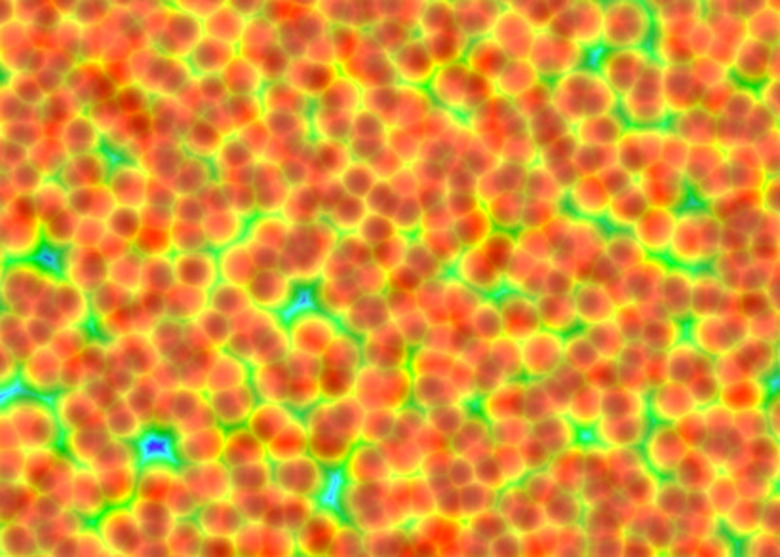What Is The Difference Between A Protist And A Human Skin Cell?
Cell types can be divided into two top-level categories: _Prokaryota, which are mostly single-celled organisms with cells lacking nuclei and other membrane-bound organelles and Eukaryota_, which include animals, plants, protists and fungi and whose cells are rich in both organelles and diversity of appearance. As an example of the latter, human cells come in at least 200 different types, including skin cells.
Typical representatives of Eukaryota are animals, plants and fungi. But one category of eukaryotes is set nominally aside as a catch-all for every kind of organism that meets the criteria for belonging in this group, yet doesn't qualify as any of the other three kinds of eukaryotes.
This "forgotten" branch of the eukaryote family tree is the kingdom Protista, made up of protists. This category of organisms is diverse, yet at the same time characterized by a lack of specialized tissues.
What Is a Cell?
What Is a Cell?
Cells are the smallest irreducible structures that, by themselves, retain all of the properties of life. These properties include metabolism, which cells demonstrate in abundance in both the "building up" and "breaking down" directions, organization and structure and a means of reproducing.
All cells have a cell membrane forming the external boundary, cytoplasm forming most of the "gelatinous" interior, genetic material in the form of DNA (deoxyribonucleic acid) and ribosomes, which make proteins. Eukaryotic cells, which are descended from prokaryotic cells in a relationship going back several billion years, also have a smattering of other specialized components, called organelles.
In eukaryotes such as protists, some cells in glands called gonads are set aside to divide into gametes, or sex cells. This happens in a process called _meiosis_.
The overwhelming majority of cells in your body, however, form and divide via a process called mitosis, a form of asexual reproduction akin to basic duplication. Prokaryotes, on the other hand, reproduce only asexually, and do so in a process similar to mitosis called **binary fission**.
Types of Cells
Types of Cells
Human and animal cells in general, plus those in plants, fungi (including yeasts) and protists, demonstrate the various features of eukaryotic cells, albeit in a range of ways.
Under a microscope, the most prominent thing distinguishing eukaryotic cells from their simpler prokaryotic counterparts is the presence of various membrane-bound organelles. The DNA is enclosed in a nucleus; mitochondria, vacuoles and other membranous internal structures are prominent.
Eukaryotes are often distinguished from prokaryotes on the basis of the former being multicellular and the latter unicellular. While this is a good rule of thumb, it is not absolute. For example, single-celled eukaryotes exist. Unicellular eukaryotes include certain protists known as algae and a class of single-celled organisms called protozoa.
What's a Protist?
What's a Protist?
A protist, or a member of the kingdom Protista, is a member of a group that is defined really more by what it is does not include (i.e., organisms that are clearly animals, plants or fungi of some sort) than by what it does. As a result, its membership is broad and the criteria somewhat hazy.
Up to 20,000 protist species are believed to exist. Protists are usually classified as either fungi-like, animal-like or plant-like based on their specific characteristics.
For example, plant-like protist cells usually contain chloroplasts and thus are capable of photosynthesis (using sunlight to make glucose or other sugars from carbon dioxide). Differences between protists and animals are similarly a matter of scale.
Types of Human Cells and Tissue
Types of Human Cells and Tissue
Even multicellular protists like seaweed show little specialization across the organism. Contrast this with your own body, which contains more than 200 types of cells.
These are organized into four basic kinds of tissue: epithelium (including human skin cells and other "linings" inside the body), connective tissue such as bone and cartilage, muscle tissue and nervous tissue.
In short, human cells are usually highly specialized based on function and tissue type while protist cells are, while also eukaryotic, still simple.
Cite This Article
MLA
Beck, Kevin. "What Is The Difference Between A Protist And A Human Skin Cell?" sciencing.com, https://www.sciencing.com/difference-protist-human-skin-cell-6747563/. 17 June 2019.
APA
Beck, Kevin. (2019, June 17). What Is The Difference Between A Protist And A Human Skin Cell?. sciencing.com. Retrieved from https://www.sciencing.com/difference-protist-human-skin-cell-6747563/
Chicago
Beck, Kevin. What Is The Difference Between A Protist And A Human Skin Cell? last modified March 24, 2022. https://www.sciencing.com/difference-protist-human-skin-cell-6747563/
